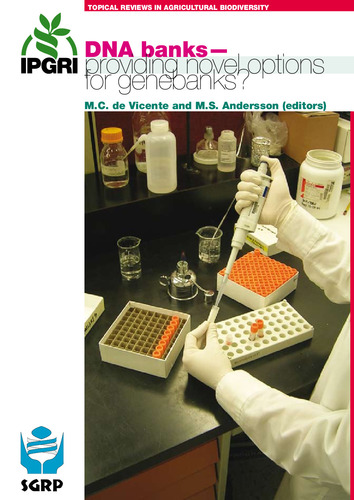DNA banks - providing novel options for genebanks?
The rapidly expanding study of DNA in so many areas of science has created an odd surplus: the DNA itself. Reasonably easy and inexpensive to store, with established techniques for almost infinite multiplication, the samples of DNA created in laboratories around the world have almost by accident become an important resource for future research. Participants at an IPGRI-organized meeting on The Evolving Role of Genebanks in the Fast-Developing Field of Molecular Genetics (see de Vicente MC, editor. The Evolving Role of Genebanks in the Fast-developing Field of Molecular Genetics. Issues in Genetic Resources No. 11. IPGRI, Rome, Italy; 2004) discussed informally how a more organized and collaborative approach to DNA banking might benefit the conservation and use of genetic resources and other areas of research. Those discussions prompted IPGRI to undertake a worldwide survey, which in turn resulted in this book. As will be seen from the individual chapters, DNA banking is not at present widespread (fewer than 20% of the institutions responding to a survey bank DNA) but would be welcomed (more than half of the respondents expressed interest in banking DNA). The book also presents considerable evidence of the ways in which DNA banking, by permitting relatively easy transfer and analysis of genetic material, can improve genebank management, plant breeding, conservation, population studies, and many other subjects. Taken together, these suggest that there is indeed a need for practitioners to cooperate to develop the kind of collaborative system envisaged in this book. Many issues remain to be sorted out. Some are extremely practical: how should DNA banks be physically arranged and should they store both DNA and the tissues from which it was extracted? How should DNA samples be distributed? Others hinge on technical issues: what are the best bioinformatic methods to tie together the various strands of information and the DNA samples from which the information was derived? Yet others involve high-level policy decisions: what rules and procedures will govern the exchange of DNA samples and sequence information, and how will access and benefit sharing, including the benefits of further research on the samples, be governed? By pulling together so many individual experiences and perspectives this book sets out several signposts that will help to guide further discussion and elaboration of DNA banking. It should be stressed that none of the contributors sees DNA banking as a substitute for the conservation of genetic resources. DNA banks complement conservation strategies that make use of ex situ and in situ conservation, and they can help to ensure the optimal use of plant and animal populations. DNA banks are probably not going to permit the resurrection of extinct populations. But their potential to enhance so many aspects of the use and conservation of genetic resources makes them an important topic for further discussion and elaboration, to which we hope this book will make a useful and distinct contribution.

